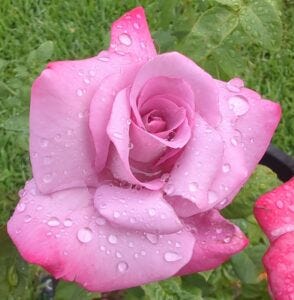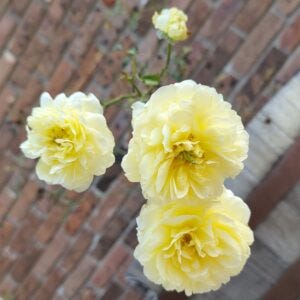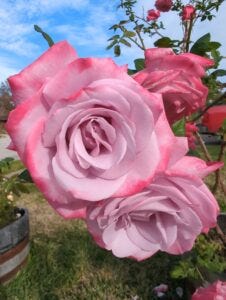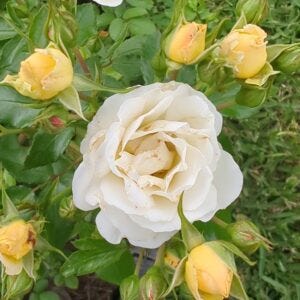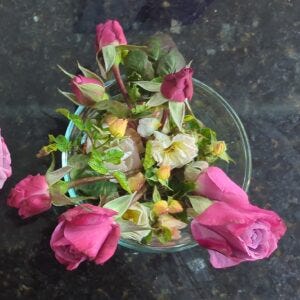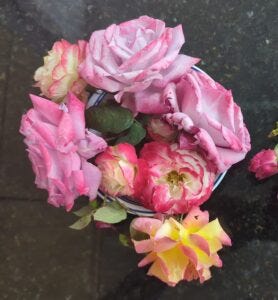Sunday Salutations and Fragile Uniqueness
Of Cats, Roses, and Seasonal Storms
My sister suggested today’s topic be seasonal storms as yesterday Tod and I spent most of the day preparing for the cold front that will blow through Houston and turn our lovely 65F degree weather into something much, much colder. Which meant that yesterday we spent most of it preparing. After all Houston houses and plants are not really used to what feels like random triennial to quinquennial freezes.
Tod cleaned the garage so we could move some of the smaller outside plants in there. And I cut back my roses, most of which are hybrid tea roses.
I have a LOT of rose bushes (8 in the front and another 11 in the back). I counted and was a little surprised. I guess 19 is a good number to stop as it a prime number, and if I want to go up the next prime is 23. If you didn’t know I have a thing for prime numbers and uniqueness.
For roses, I mostly have chosen the more peculiar colors such as peach, purples, or multicolored rose. Just like in animals where I love the wonderful mutants that make them have distinct fur patterns.
Some of my favorites in cats are:
Lyonization patterns which causes calico patterning. This is mostly caused by the semi-random mosaic natures of X inactivation chromosome (aka Lyonization) in cats with multiple X chromosomes. Standard female cats have 2 X chromosomes, which explains why most calicos are female. The ones that are male usually are actually XXY. Like almost all biology there are exceptions. I really liked the book “Cats are Not Peas: A Calico History of Genetics” which covers a lot about calico genetics. Tod’s best friend got it for me a long time ago.
Acromelanism, point coloration, also known as heat sensitive pigmentation patterning. The most well-known of these is the partial albinism in Siamese and Ragdoll cats where they have darker extremities (ears, nose, face, paws) and a paler body. It is caused by a mutated enzyme involved in melanin production which is thermolabile, meaning it is sensitive to temperature. The temperature difference between the body and the extremities causes the color differentiation. Acromelanism occurs in a number of mammal species.
In dogs, specifically Mini American Shepherds, I love:
Bicolor and tricolor which are defined by combinations of over 10 different genes. The combination of these genes generates the white, black, and tan markings. I am still learning about the different color combinations.
Merles are amazingly beautiful, but possibly dangerous. Dogs with two copies of the SILV gene are born either deaf or blind or do not survive birth. A single copy results in the molted pattern of blue (grey) and red (brown) merles. The merle pattern as well the genes for not having tails are a very important consideration for Australian and Mini American Shepherd breeders.
It feels odd that such spectacular color patterns represent more than just uniqueness and can result in defects and death if one does not treat the breeding lines with knowledge and reverence. One of the most popular colors in dogs is merles, but breeding for this color without forethought could be very deleterious to the breed and the overall health of the dogs produced – it is a fragile uniqueness.
So, it is unsurprising I have a similar love for the unique colors of roses. And if I had unlimited time and resources, I would love to breed new rose varieties almost as much as I would like to run my own kennel. I often think I am lured by fragile uniqueness, maybe because I relate to it. If you pay attention, you might notice similar fragile uniqueness becomes the foundation of self-awareness and strength in some of our characters in our longer pieces.
Which makes it unsurprising that my favorites roses are:
Striped roses – the purple tiger or red striped Scentimental, or other varieties which are caused by sports or gene mutations that arose spontaneously and then are bred to be permanent.
Bicolored roses – like the Passion, which is light purple tipped with pink, and also has yellow-pink and white-pink varieties.
Fading roses – Tod’s favorite is the Popcorn Rose which starts out yellow and turn white – which is caused by a washed-out or knock-out mutation. Pastel colors, such as pinks or yellows, fade to white. This is partly caused by being darker in cold weather and lighter in hot weather. In a way I guess the pigment might be being washed-out by the sun – which occurs so clearly in this rose variety.
Purple roses – These roses are purple toned in low temperatures but often look more magenta-pink than truly purple in Houston. It is another example of temperature affecting color in roses, not just in cats. It is so interesting to me that colors can be so influenced by the temperature – I haven’t studied this enough to know if it is due to bleaching of the sun or to something else like protein folding changes…
For me, the saddest part of preparing for the freeze was cutting back the roses that might have bloomed into darker colors. I had to cut off so many blooms, in the hopes of helping the roses to thrive after our freeze. I cut so many that I ended up preparing two bowls of rose blooms and buds. Tod was helpful and provided pictures of the wonderful blooms.
However, we have had to hide these away a little bit as the cats have decided that these bowls of flowers are for them to play with, pull apart, scatter on the floor, and eat. Somehow, rose petals scattered on the floor sounds so much prettier and more romantic than it is… or maybe was because of how they were half scattered, half spilled as only a cat can do. (Picture of the culprit – Beleth the rose petal scatterer.)
Other Updates:
I am almost done with my edits / rewrites on our first novel. Yay! I have learned a lot about myself as a writer from the edits, but that is next week’s blog. I am planning to write up what I have learned about self-editing, editing with a partner, and overall writing.
I hope that everyone else is doing well. I am still recovering some. I hope life, work, and my health will settle down this year. And I hope everyone else’s life is calmer than mine.
May you, too, find a way for your fragile uniqueness to become your guiding strength.
Until I write again…
~Anna


